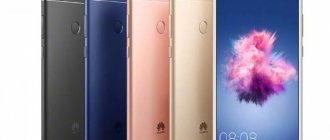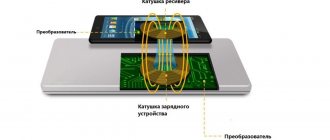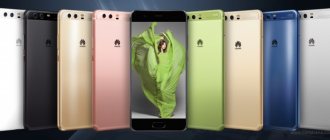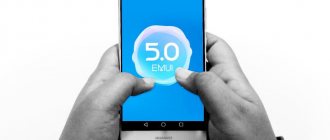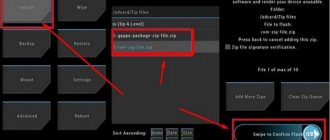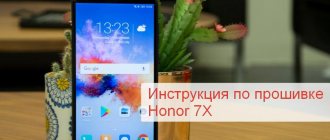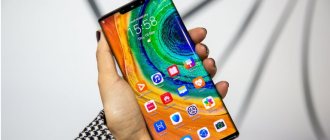Huawei Honor V9 Review
Huawei Honor V9 is a powerful mid-range smartphone. It was introduced in China in February 2021. The device has a very attractive design, as well as innovative functions and progressive filling.
Appearance and ergonomics
The new Huawei Honor B9 has a monolithic aluminum body with rounded corners, reminiscent of the iPhone 7. It looks very neat, impressive and stylish. On the matte back there is not only a round fingerprint scanner, but also a dual camera and flash. The front part looks attractive thanks to the glossy 2.5 glass that covers the entire huge screen. There is a USB Type-C connector and a 4000 mAh battery.
Dimensions of Honor V9: height - 157 mm, thickness - 6.97 mm, width - 77.5 mm, weight - 184 g. Colors - blue, black, gold and red. The device, although large, is relatively comfortable to hold in your hand due to advanced materials, smooth corners and moderate weight.
Display
The Honor B9 smartphone is equipped with a truly massive 5.7-inch screen, the resolution of which is 2560 by 1440 pixels (Quad HD). The display is covered with fairly thick glass. The quality of the LTPS LCD matrix is not satisfactory, and the image always remains detailed and natural. There are also on-screen buttons, which have become the norm for mobile devices with touch screens.
Hardware and performance
The internal filling of Huawei Honor V9 stands out with incredible power. The device has a Kirin 960 processor with a frequency of 2400 MHz and eight cores, as well as a powerful Mali-G71 graphics accelerator. My memory is doing very well. There are two versions of the smartphone - with 4 GB or 6 GB of RAM. In the first case, the device receives 64 GB for storing files, and in the second - 128 GB. At the same time, the memory can be expanded even further using MicroSD cards (up to 1 TB).
Huawei Honor V9 runs on the Android 7.0 platform with the exclusive EMUI 5.0 interface. The power of the smartphone will be enough for several years to come.
Communication and sound
The gadget supports two SIM cards, as well as LTE and Wi-Fi networks (802.11 a/b/g/n/ac). The volume of the external speaker is above average. Music sounds quite clear, but things are even better with headphones. It’s really pleasant to talk with your interlocutors, since there are no extraneous noises or interruptions in communication.
Camera
Honor V9 can be called a smartphone for taking artistic photographs. It has a dual 12-megapixel camera with f/2.2 aperture and a powerful flash. There is laser focusing, which is accurate and fast. The device has depth of field, allowing users to adjust many nuances during the shooting process.
At the official presentation, it was not for nothing that the smartphone was compared with the well-known new product from Apple in terms of photographic capabilities. Moreover, the camera can produce 3D photos that can be printed on an appropriate printer. It is also worth highlighting the presence of an 8-megapixel front module.
conclusions
Honor B9 is positioned as a middle-class smartphone with a flagship design and hardware. Prices for the gadget start at $430 at the start of sales. With this smartphone, the user receives a productive and beautiful device with several innovative technologies.
Pros:
- Dual camera with 3D photo.
- Powerful iron.
- Abundance of memory.
- Big screen.
- Premium design.
Minuses:
- Significant price.
- Not the loudest sound.
Appearance of the smartphone
Huawei designers did their best, the smartphone looks very attractive, 2.5D glass, thin metal body, no protruding cameras. The phone looks stylish and expensive, but let's talk about everything in order.
The front of the smartphone is completely covered with 2.5D glass, which is rounded at the edges, making it look so stylish. The company name is proudly displayed at the bottom, and there are the usual three touch buttons. By the way, the buttons can be reconfigured from the operating system to suit you.
At the top of the smartphone there is a so-called selfie camera, which, by the way, does a very good job.
On the right side there is a rocker for changing the volume level and an on/off button. The buttons feel metallic, and the on/off button also has a rough surface. Apparently so that you don’t confuse them by touch in your pocket.
On the left side there is only a tray for SIM cards/memory cards. I would like to draw your attention to the beveled sides and stripes at the top and bottom, exactly the same as the iPhone 6S.
On the bottom edge of the smartphone you will find a headphone jack, a Type C charging connector, a speaker and a microphone. I don’t want to do it again, but it’s simply impossible not to once again draw a parallel with the apple product, because the “inspiration” was clearly drawn from there.
On the back side, in the center of the case, there is a fingerprint scanner for unlocking the phone and quickly logging into some applications. And above that lives the most interesting part of this smartphone - the dual-lens camera, developed together with Leica. Next to the lenses are two LEDs for the flash. Judging by their appearance, the LEDs are of different color temperatures.
The SIM card tray can be removed using a paperclip, which we hope is included in the kit. We took a similar one from the iPhone, and of course it fit. In this version of the phone you can install either two SIM cards that will work simultaneously, or one SIM card and an additional memory card to increase the memory capacity, which is 32GB by default for each model.
Technical characteristics of Huawei Honor V9
| General characteristics | |
| Model | Honor V9, DUK-AL20, DUK-AL20 |
| Date of announcement/start of sales | February 2021 / March 2017 |
| Dimensions | 157 × 77.5 × 6.97 mm. |
| Weight | 184 |
| Case color range | Blue, red, black, gold |
| Number and type of SIM cards | Dual SIM (Nano-SIM, dual stand-by) |
| operating system | Android 7.0 (Nougat) |
| Communication standard in 2G networks | GSM 850 / 900 / 1800 / 1900 - SIM 1 & SIM 2 |
| Communication standard in 3G networks | HSDPA 850 / 900 / 1900 / 2100 |
| Communication standard in 4G networks | LTE band 1(2100), 3(1800), 5(850), 7(2600), 8(900), 20(800), 38(2600), 40(2300) |
| Display | |
| Screen type | LTPS LCD capacitive touchscreen, 16 million colors |
| Screen size | 5.7 inches |
| Screen resolution | 1440 x 2560 @515 ppi |
| Multitouch | There is |
| Screen protection | Tempered glass with 2.5D rounding technology |
| Sound | |
| 3.5mm jack | There is |
| FM radio | No |
| Additionally | |
| Data transfer | |
| USB | 2.0, Type-C 1.0 reversible connector, USB On-The-Go |
| Satellite navigation | A-GPS, GLONASS, BDS |
| WLAN | Wi-Fi 802.11 a/b/g/n/ac, dual-band, DLNA, WiFi Direct, hotspot |
| Bluetooth | 4.2, A2DP, LE |
| Internet connection | LTE-A, HSPA, EDGE, GPRS |
| NFC | There is |
| Platform | |
| CPU | Kirin 960 (4×2.4 GHz Cortex-A73 & 4×1.8 GHz Cortex-A53) |
| GPU | Mali-G71 MP8 |
| RAM | 4 GB / 6 GB RAM |
| Inner memory | 64 GB / 128 GB |
| Supported memory cards | microSD up to 1TB |
| Camera | |
| Camera | Dual 12 MP, f/2.2, phase detection and laser autofocus, dual-LED (dual tone) flash |
| Camera functions | Geo-tagging, touch focus, face detection, HDR, panorama |
| Video recording | [email protected] |
| Front-camera | 8 MP, f/2.0, 1080p |
| Battery | |
| Battery type and capacity | 4000 mAh, non-removable |
| Additionally | |
| Sensors | Light, proximity, fingerprint reading, accelerometer, gyroscope, compass |
| Browser | HTML5 |
| IMAP, POP3, SMTP | |
| Other | — Fast battery charging — Google Search, Maps, Gmail, Talk — XviD/MP4/H.265 player — MP3/eAAC+/WAV/Flac player — Document viewer — Photo/video editor — Organizer — Voice dialing, voice commands, voice recording |
| Equipment | |
| Standard equipment | Honor V9: 1 USB cable: 1 User manual: 1 Warranty card: 1 Charger 9V/2A: 1 |
Battery
The battery is the second strong point of the Huawei P9. If you tell someone that an android is quickly discharged, this will not lead to surprise at all, because for everyone this has already become the norm. But not this time, because Huawei P9 lasts a very long time without recharging. We tested it in two modes: with load and everyday. For the “under load” mode, we installed the 3DMark benchmark and ran the most powerful text in a circle. The result exceeded our expectations - 5 hours 40 minutes. In normal use, the phone lasted almost two days without recharging, this is a very decent result.
This operating time of the device is a combination of several factors. Firstly, there is a 3000 mAh battery. And secondly, of course, good software and a shell that does not eat up unnecessary resources.
Performance
The system performance is excellent, as evidenced by the test results, screenshots of which you will find below. What I especially liked is that the smartphone does not get hot even in the most severe applications. All modern games will run without problems on Huawei P9.
Camera Features
Smartphone developers are not shy about collaborating with manufacturers of professional and most expensive optics. Practice has shown that such an approach more than pays off in the quality of photographs. For an example, you don’t have to go far: Nokia, which became friends with the German Carl Zeiss, became a pioneer in this area. As a result, the photo quality of the 2-megapixel camera of the Nokia N90 smartphone was very good for that time. Let us remember that it was 2005 at that time.
Huawei decided to follow a slightly similar path. The P9 dual camera was released in collaboration with another famous German company – Leica. Perhaps, a dual camera on smartphones is even less common than optics from famous German manufacturers. However, if you start to understand this topic more deeply, it turns out that the main cameras of Huawei P9 use a pair of 12-megapixel Sony IMX286 modules, and the lenses are made by the Chinese company Sunny Optical. At the same time, on the back of the smartphone is the proud name Summarit, which is found on Leica lenses. By the way, such “optics” cost quite a lot - from 99,000 rubles for the simplest, “hand glass”. Is Huawei P9 really only a loud name left from the famous Leica? Well, let's find out.
Let's return to the dual camera of the smartphone. The first, color matrix reads information about color, and the second, monochrome matrix, is responsible for transmitting light. A fresh and quite nice take on mobile photography that increases dynamic range and improves photo quality in the dark. As for the technical characteristics, both lenses have an f/2.2 aperture, dual LED flash and laser autofocus. By the way, it is worth separately praising Huawei for the fact that the front camera lenses are flush with the body and do not protrude from it, as is done in the case of competitors. For example, this problem is observed even with the public’s favorite iPhone 6S.
Now let's move on to the camera interface. It is clearly noticeable that specialists from Leica worked here. At first glance, the P9 camera interface is similar to everything we've seen before in the EMUI shell, but if you take a closer look, it becomes clear that the icons and fonts are the same as what we saw on professional Leica cameras.
The P9's shooting capabilities are very rich. In addition to a large number of automatic shooting options (photo, monochrome, decoration, panorama, HDR and light), the camera has a fully manual mode that will interest photographers. In this mode, you can manually set all photography parameters. Shutter speed, exposure and focus modes, white balance and manual focus. To complete the picture, it’s worth adding that Huawei P9 is trained to shoot in RAW. Therefore, if your version of the smartphone does not have a slot for a memory card, and you plan to shoot in RAW, then you should take a closer look at the P9 with a large amount of memory.
Now let's move on to the most interesting part, the picture quality. The Huawei P9 takes amazing photos even though the lenses were made by a Chinese company. The work of Leica engineers is clearly felt when working with the camera. Daytime shots come out nice and bright, with rich, true-to-life colors. Perhaps, when shooting during the day, the dual camera in the Huawei P9 leaves even the iPhone 6S camera far behind.
The Huawei P9 also coped well with macro photography. But when shooting at night, the camera starts to smear - this is due to the lack of a stabilizer. But fortunately, the “smudges” are small and will only be noticeable on the screen of a large laptop or PC display. On the one hand, this is an unpleasant feature, but on the other hand, if we look at photos taken by the P9 only on other mobile devices, the image blur will not be so noticeable.
As for the autofocus performance, during tests we could not find fault with it. autofocus always worked quickly and clearly, even at night. The thing is that in addition to laser autofocus, the P9 dual camera also has a classic phase-detection focusing system. The laser can work when shooting at close distances, and the phase system can work in all other cases. Additionally, both focusing systems can work together, depending on the complexity of the shot. It's this approach that makes the P9's autofocus system so fast and precise. By the way, the P9 also has a software background blur system with post-focus. This is a separate shooting mode, thanks to which you can change the focus area after taking the frame. This is an oldie but a goodie that can be found on many Huawei smartphones, including those equipped with a single camera.
Finally, it’s worth talking about video shooting. Unfortunately, Huawei P9 cannot shoot in 4K format. You will have to shoot video in resolution up to classic FullHD, but the frame rate can be increased to 60 FPS.
As for the Huawei P9 selfie camera, it also turned out to be very nice. Of course, there is only one and is not equipped with Leykovsky optics or autofocus. Its resolution is 8 megapixels and the aperture is ƒ/2.4. However, this camera copes with its main task perfectly well, and is subjectively better than the iPhone 6S.
